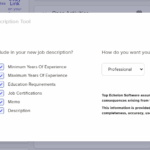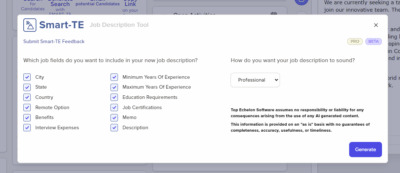In my previous blog post for the Top Echelon Recruiter Training Blog, I discussed the top 5 reasons recruiters don’t close the deal. That post leads us effortlessly to this blog post, which deal with the types of recruiting closes that you can use.
I call these recruiting closes “classic closes.” That’s because not only have they been around for a while, but they’re also incredibly effective . . . if implemented and executed properly.
15 tips for how to close a candidate
#1—Order Blank
This close comes from the real estate industry, automotive industry, and major appliance industry. The salesperson pulls out a form and starts filling it out and as long as you don’t stop them, then you are buying. If you try to stop them, they will say that they merely use the form to keep their thoughts organized. Then, when they are finished, they turn the form around to you and ask you to okay it and they will submit your offer.
In our business, this would be a send-out slip, a job order form, etc. It is best to use this close in person, but this is not always possible since most of us work over the telephone. An invoice worksheet works very well when using this close.
#2—Alternate of Choice
This close comes from the egg industry. Apparently in the Midwest in the 1920s and 30s, there was a malt shop that was selling more eggs than anyone in the country. So, the head of the egg industry visited the malt shop to find out why. When questioned, the malt shop owner said that he never sold any eggs with his malts until he changed his sales approach and started asking the customers, “Do you want one egg or two in your malt.” The customer would then choose between the options, and the malt shop’s egg sales soared.
In our business, this is a way to avoid close-ended questions: those that can be answered by responding “Yes” or “No.” Many of you, when presenting your candidates for interviews, use this close. “My candidate is available to speak with you on Monday or Tuesday. Which day is better for you?”
You don’t ask IF they want to see your candidate. You ask WHEN they want to see your candidate.
#3—Puppy Dog
This close comes from the television industry in the 1940s and 50s in New Jersey, when color TV was just becoming a reality. Customers would come into the showrooms and look at this new format. One TV outlet that sold more color TVs than any other would have their salespeople say, “You can’t really tell what this TV is going to look like until you see it in your own front room or den. Why not take it home and try it out? If you like it, then you can buy it. If you don’t, we’ll pick it up.”
Then, in about a week, the retailer’s color TV technician would show up at the customer’s house to see if the reception was still okay. No close on this visit. The retailer said that usually within another week, the father figure would come back to the store and ask how much the darn TV was. You see, he couldn’t return it now. He would look like the biggest villain of all time in the eyes of his family if he did. Indeed, if you ever have a puppy that you want to get rid of, just ask a friend to watch it for a short time. After your friend names the puppy, they’ll never give it back—thus, “The Puppy Dog Close.”
This is sometimes used when you arrange “creative send-outs”—when you are arranging demonstrations where no real job order exists. You can also use it in the form of early project work or temp work to engage your clients and candidates when a long start date is anticipated.
#4—Ben Franklin
This is also called the “Ben Franklin Balance Sheet Close.” Sometimes it’s called “Baconian Empiricism through Enumeration” and is actually still in Poor Richard’s Almanac. This is apparently how Ben Franklin would make his decisions. When faced with the need to make a decision, old Ben would take out a blank sheet of paper and draw a line down the middle. Then he would write down all of the reasons for doing something on the left-hand side of the paper and all of the reasons for not doing something on the right-hand side. Then he would add up the columns, and the column with the highest number determined his choice.
In recruitment, this is great for either a candidate or a hiring manager who has a lot of information. Their thinking becomes cluttered. By itemizing the information, you help clarify their thinking. Then you help them with the choices in the column you want them to pick (keeping in mind that they have to say it—not you—in order for it to be true). Once you finish with your column’s choices, you refer them to the other column and now you don’t help anymore—i.e., shut up! If they can come up with more than just a couple of entries, it will be a miracle. Then you add up both columns and, hopefully, your column wins.
#5—Negative Yes
This is sometimes called the “Is It . . . Close.” This is for the candidate or hiring manager who is the opposite of the ones we just talked about. These folks give us no information. They are just not sure of what the problem is. Trying to get information out of these people is like attacking an amorphous mass, a cloud. So what we are going to do with this close is to attempt to isolate the real objection.
Let’s say that we’re trying to close a hiring manager. This is what we say: “Okay, June, but just to clarify my thinking, what is it that bothers you about Jim? Is it his education?” You don’t hesitate after you say “What bothers you about Jim?” or the hiring manager might say “Everything,” and you are right back where you started.
So go right into your series of “is it’s” without stopping.
At this point, the manager will usually answer “No,”—thus the “Negative Yes” or “No Means Yes” recruiting closes.
Then you follow with, “Is it his professional background?” She says No. “Is it how he interviewed?”
She says “No,” etc.
See what you’re doing? One by one, you’re taking away the objections and determining what really is the final objection. Then you can attack that objection.
#6—Call back
The odds are not in your favor when you get this request, but there is a way to handle the call when you do call back. For those of you who know of the principle of “White Heat,” keep in mind that we are going to attempt to raise the interest level above the “Buy Line.” This is such a prevalent topic in recruiting that we even have an expression for it. We say, “Time kills all of our deals.” That’s why calling back after a period of time is not a good thing. So, when you do call back you never ask if they have thought about the situation in the intervening time span. If you do, you are going to get the famous “Yes-No” response—“Yes I have thought about it; No I am not interested.” Instead you:
- Introduce a new piece of information
- Present a condensed representation
- Follow with a new close
Only when you do those three things, do you have a chance, remote though it might be, to raise the interest level above the “Buy Line” and close the deal in your favor.
#7—Similar Situation
The “Similar Situation Close” is sometimes called the “Story Close” or the “Back up the Hearse and Let Them Smell the Roses Close.” This one comes from the insurance industry. This is used when the insurance salesman has received the “I want to think it over” response from his prospects. So, before he leaves, he relates a story of a similar situation that happened not too long ago when a couple, not unlike this couple, with a young daughter, not unlike their daughter, wanted to think it over.
Then, as the story continues, the original couple was unfortunately killed in a car accident shortly thereafter and all the insurance salesman can think about is that if he had been a better salesman, the couple’s little girl would have been provided with insurance money for the rest of her life instead of being left a penniless orphan. There is a little more to this close than that, but you probably get the idea.
In recruitment, those of you who have some tenure have plenty of similar situations to tell both your candidates and your hiring managers regarding waiting too long to make a decision and then having the original offer/candidate disappear. Just make sure that the stories are relatable to your target audience.
#8—Lost sale
In this close, you act defeated. You seemingly give up. Then ask a self-effacing question like, “I need your help. What could I have done better to have brought this deal together so that I don’t make this same mistake again?” Their response may bring you right back into the situation and you will at least have uncovered the real objection.
#9—Secondary question
This close is out of real estate, out of car sales. This is sometimes called a “Major-Minor Close.” The salesperson says, “The car is $40,000. I just need your OK on the agreement. Do you want to use your pen or mine?” The choice of pens is the secondary question that closes the major question.
In our industry you might say, “I am assuming that you want John to start at the beginning of the month. Now should John bring another resume with him at that point or just come as he did today?” The answer to bringing the resume tells you that they want John to start.
#10—Sharp angle (“Porcupine”)
If someone threw a porcupine at you, you would throw it back at them. Or if something was shot at you, you would shoot it back at a sharp angle. This close is one of my favorites.
You have been trained all of your life that if you know the answer to a question, you should answer the question. You have become a little giver of information. The problem is, in recruitment, you don’t get anywhere by answering question after question like you did in school.
What happens often in recruitment is that you tend to answer all of the questions asked of you by the hiring manager when you are presenting a candidate only to be ultimately asked to send the resume. Well, that’s not what you wanted. You wanted to set up a telephone interview or a face-to-face interview. So, instead of acting like a non-profit information clearing house (though if you would enjoy that, you might look at a career as a reference librarian), I recommend you close on each question asked of you before you answer it.
So, for example, the manager asks if your candidate has a college degree. You say, “Well, let me check, but if he does have a college degree, would you like to see him on Monday or would Tuesday be better?” If the hiring manager says neither, then why are you looking to see if your candidate has a college degree? You see, the point is that once the manager asks you a question about your candidate, he has just arranged the interview and you let him off of the hook by only answering the question instead of closing on the question.
#11—Tie-Downs
There are three types of tie downs: The regular tie-down, the inverted tie-down, and the tie-down tag-on. The basic idea with a tie-down is that if someone is moving their head up and down in a positive way, it is difficult to stop that movement and change to a negative side-to-side movement.
The regular tie-down: You say, “Boy, he really does have the experience you’re looking for, doesn’t he!” “Doesn’t he” is the tie-down. “And he would be good for your company, wouldn’t he?” “Wouldn’t he” is the tie-down.
The inverted tie down: You lead with the tie-down. You say, “Doesn’t he have the experience you are looking for?” The tie-down comes at the beginning. You say, “Wouldn’t he be a great addition to your company?” Again, the tie-down comes at the beginning.
The tie-down tag-on: They say, “Boy he really does have the experience we’re looking for.” And you say, “Doesn’t he!” “Doesn’t he” is the tag-on. They say, “And he really would be a great addition to our company.” And you say, “Wouldn’t he!” “Wouldn’t he” is the tag-on.
#12—What If?
The “What If?” close brings non-overlapping situations together. Let’s say that you believe the offer is going to come in at $60,000 and you know that the candidate won’t take anything less than $61,000. Well, you have a $1,000 problem. In this situation, we want to focus on “psyticements” (psychological enticements) such as an expense account, a company car, immediate health benefits (good for candidates with families), early merit reviews, corner offices with windows, etc.
We’re looking for more ammunition before we fire our “offer cannon.” So for example, we go to our candidate and say, “I was thinking about this last night and what if we go for immediate health benefits (to cover your five kids) and an expense account. But let’s go in a little bit lower, at let’s say $60,000, to make this package more attractive for the company. Now in the long run, by adding those two items, you’ll be making more than the $61,000 you were after. What if we did that?”
If the candidate agrees, then we go back to the company and negotiate those two items. In most companies (especially larger companies), salaries are not too movable. Instead, they are “slotted.” The last thing a company wants to do is to give a new candidate a larger than normal salary. That’s because when it gets out to the other tenured employees, a number of them will quit. But “psyticements” are movable, and we as recruiters need to focus more on those and less on salaries. (Even though a percentage of the salary, or realistic first year’s earnings, is how most of us are paid and explains our fixation on that number. It’s a shame that we do that.)
#13—If I, Will You?
So you say to the hiring manager, “If I cut my fee to 25%, will you give me a decision after each of my candidates is interviewed within 24 hours?”
Or you say, “If I agree to 25%, will you agree to interview everyone I present without a resume since I will be recruiting candidates who are happy, well-appreciated, making good money, and currently working and normally will not have a resume?”
In other words, if you give something, you need to get something. It needs to be fair. It needs to be equitable.
#14—Reduce to the Ridiculous
This close is for money problems and is based on an amortization table.
Let’s take a fee problem. The fee the hiring manager wants to pay is 25%, and let’s say your candidate makes $60,000. So that is a $15,000 fee. At a normal fee of 30%, the fee is $18,000. So we have a $3,000 problem. This is what we say to the manager: “You know, Mr. Hiring Manager, the difference in our fee amounts is $3,000. But let’s think of that $3,000 in a little different way. If you take the $3,000 and amortize it over one “work” year, you get $1.44 per hour. Now, how long do your employees normally stay with you?”
The hiring manager says four years. So you continue, “Four years is pretty much the industry average. So, let’s take the $1.44 and divide it by 4 and you get 36¢. Is it worth it to you to not have a candidate of this caliber on board with your company for 36¢?” Hence the title of the close: “Reduce to the Ridiculous.”
#15—Take-Away
This is used when either side cannot make a decision. With this close, you’re going to “roll the dice” and be very assumptive. You’re not going to ask permission to take it away. You’re just going to do it. But here’s the beauty of this close: you’re either going to take it away, so the deal that was not going to go together anyway dies . . . OR you’re not going to be allowed to take it away and you will make a placement. Either way works for you.
You say to the hiring manager, “Listen, I understand your predicament. Usually in our business, if a match is going to happen, the hiring manager is going to say ‘Yes’ right away and for some reason you are not. So my sense is that this is not going to go together. But I tell you what. Why don’t we wait until 3 p.m.? If I don’t hear from you by 3 p.m. today, I’m going to call the candidate and tell him that it’s just not going to happen. And if you can make a positive decision by 3 p.m., get back to me and we will put the thing together.”
As I said before, you’ve created a win-win situation. You’ll either take it away by 3 p.m., which means it wasn’t going to go together anyway. Or you are not going to be able to take it away. They’re going to hire your candidate and you’re going to make a placement. But let’s not let this thing go off into space because it stops you from thinking, it stops you from working, and it causes you to be preoccupied “babying” these things.
So let’s put the hiring managers’ “feet to the fire.” They won’t necessarily love you when you do these take-away closes, but hopefully you didn’t get into this business to be loved. You got into this business to make serious money.
You get that through making placements—lots of them. And you get those placements by getting decisions. The take-away close is one way to get the decisions you need.








